There exists an abundance of flowers that captivate hummingbirds, but it is imperative to discover plants that can withstand and thrive in your specific weather conditions. Should the temperature be excessively hot or cold, these plants may wither away or fail to grow sufficiently, resulting in a scarcity of nectar-filled flowers for hummingbirds to gather sustenance from.
The United States Department of Agriculture (USDA) has devised a plant hardiness zone map that classifies the nation into 13 zones based on the average minimum temperature. Furthermore, within a single state, various zones may exist. Plants flourish in diverse zones and can endure minimum temperatures, yet they cannot survive if the cold becomes too extreme.
The majority of Iowa finds itself situated in Zone 5 on the plant hardiness map, although some small regions in the northwest and northeast fall into zone 4.
To complicate matters, certain plants may also struggle in excessively hot conditions. Consequently, the American Horticultural Society has created a plant heat-zone map, exhibiting the average number of days an area experiences temperatures exceeding 86 degrees Fahrenheit.
For Iowa, the heat zone map ranges from 4 to 7, with the southwestern region being warmer than the northeastern. However, it is during the cold winter months that hummingbird plants in Iowa encounter more significant challenges.
Each of these plants suitable for hummingbirds has been meticulously assessed against the cold and heat zones in Iowa, guaranteeing not only the presence of exquisite, nectar-rich flowers that hummingbirds adore, but also their capacity to flourish within Iowa’s weather conditions.
It is important to note that certain plants listed under the cold zone 5 classification may struggle to survive the harsher winters of zone 4 in Iowa without adequate protection. These include Buddleia, Crocosmia, Passionflower, Flowering currant, Desert willow, Figwort, Geranium, Indian Pink, and Cape fuchsia.
Therefore, it is highly recommended to cultivate as many of these flowers as possible to entice hummingbirds in Iowa.
Now, let’s explore a selection of hummingbird-friendly plants suitable for Iowa’s hardiness zone:
1. Nasturtiums
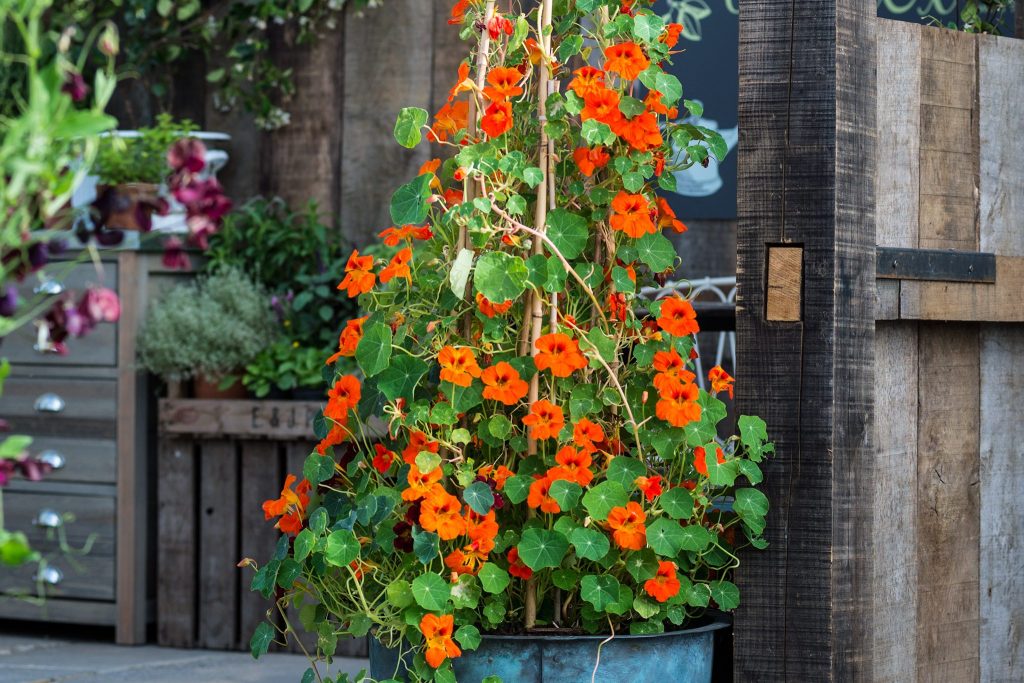
– Common Name: Nasturtiums
– Scientific Name: Tropaeolum
– Growing Zones: 2 – 11
– Sun: Full
– Soil: Well-drained
– Colors: Red, orange, yellow, pink.
– Height: 1 – 10 feet
– Spread: 1 – 3 feet
– Plant Type: Annual
2. Zinnia
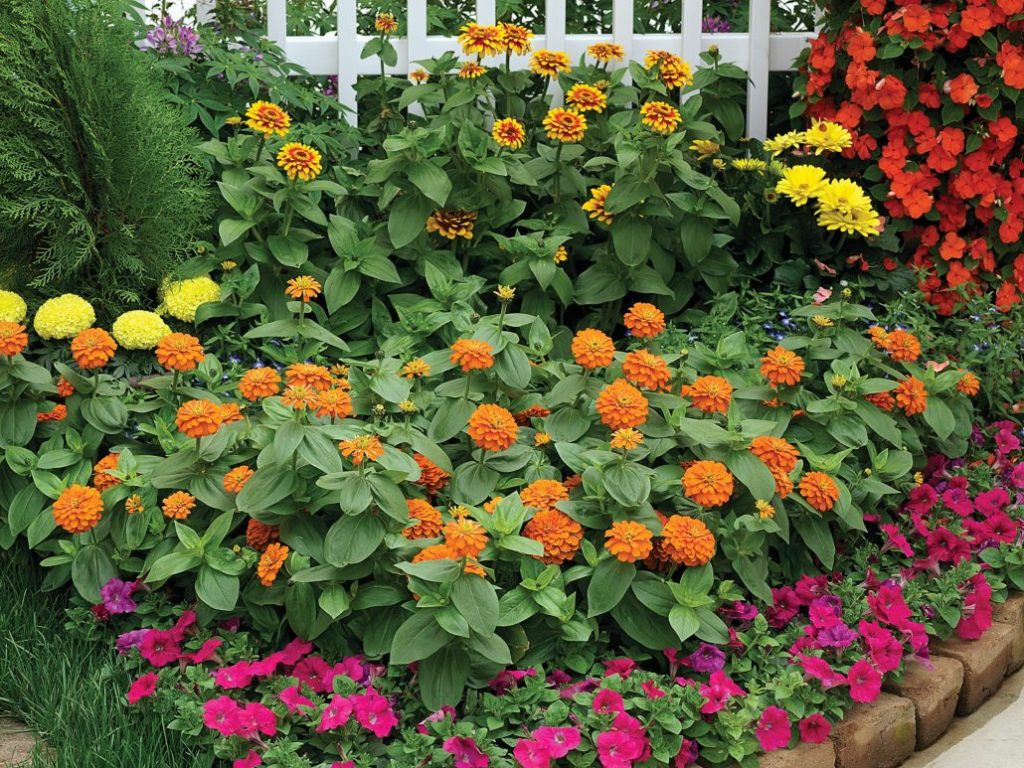
Zinnias, native to North American scrub and dry grasslands, are vibrant flowering shrubs. Belonging to the sunflower tribe (Heliantheae) within the larger daisy family (Asteraceae), they offer three main types based on petal configuration. Single-flowered zinnias possess a row of petals with a visible center, double-flowered zinnias exhibit numerous rows of petals without a visible center, and semi-double-flowered zinnias showcase numerous rows and visible centers.
Zinnia elegans, a classic variety, features tall stems and vivid colors, making it a popular choice for backyards and gardens. With a height of up to 4 feet, this zinnia bears an abundance of brilliantly-colored flowers from early summer until frost. Its allure extends to pollinators such as butterflies and hummingbirds. Cultivating zinnias is a straightforward process, but
they prefer direct planting instead of transplantation. Once established under full sun and well-draining soil, their vibrant blooms will bring prolonged joy.
– Common Name: Zinnea, Zinnia
– Scientific Name: Zinnia elegans
– Growing Zones: Annuals in 2-8, Perennials in 9-11
– Sun: Full sun
– Soil: Neutral to slightly alkaline, well-draining
– Colors: White, yellow, orange, pink, red, purple
– Height: 1 – 4 feet tall
– Spread: 12 – 18 feet wide
– Plant Type: Annual, Perennial Shrubs
3. Agastache
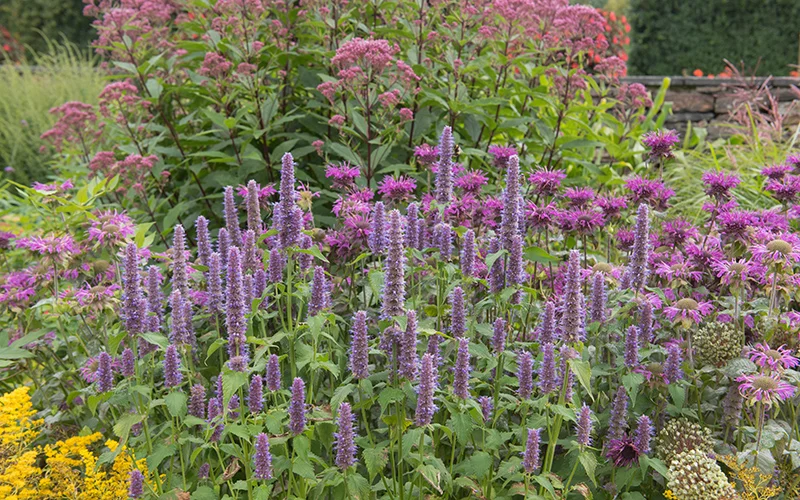
Agastache, also known as “hummingbird mints” or “Giant hyssops,” encompasses a range of aromatic herbaceous perennials. With approximately 22 species, primarily native to North America, these plants offer more than just hummingbird attraction – they can also be used for herbal tea.
The distinctive feature of Agastache flowers lies in their ability to stand out among the leaves. Composed of clusters of tiny flowers, measuring around 3 to 4 inches in length, they possess a fuzzy appearance. Their vivid purple and red colors serve as irresistible lures for hummingbirds, especially when the flowers are in full summer bloom.
To cultivate Agastache flowers successfully, start them indoors as plants in May, then transplant them into flower beds during summer. They require full sun and regular watering initially, but once established, they exhibit drought tolerance and can be left to thrive independently. As desert plants, they endure scorching days, and excessive watering should be avoided to prevent root rot.
– Common Name: Agastache, Hummingbird Mint, and Hyssop
– Scientific Name: Agastache
– Growing Zones: 3 – 10
– Sun: Full Sun
– Soil: Lean soil, well-drained
– Colors: Blue, purple, red, orange, pink, and white
– Height: 3 to 5 feet tall
– Spread: Varies
– Plant Type: Herbaceous perennial
4. Morning Glory
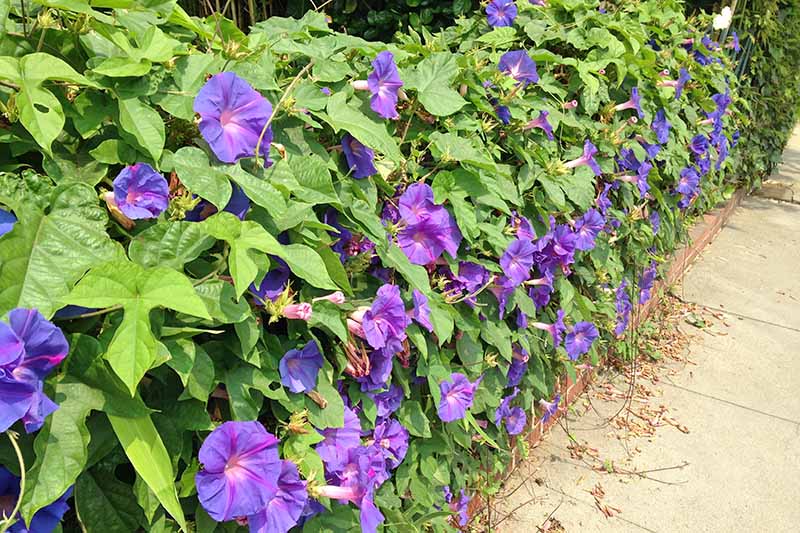
Morning Glory is a collective term encompassing over 1,000 species of flowering plants from the Convolvulaceae family. These plants earned their name due to their characteristic behavior of opening their flowers early in the morning and closing them as the day heats up. While most Morning Glory species exhibit this behavior, some variants, such as Ipomoea alba, bloom at night.
Characterized by their bright and colorful blooms, fast-growing vines, and vibrant green foliage, Morning Glory plants thrive in poor and dry soils. They are often seen twining around arbors or climbing the exterior walls of houses using trellises.
One well-known species, Ipomoea purpurea, boasts bright purple, trumpet-shaped flowers and heart-shaped leaves that open in the morning and close in the afternoon. These flowers bloom from early summer to early fall.
Morning Glory is considered an annual vine, but it may act as a perennial in milder climates. To ensure optimal growth, they require full sun exposure, approximately 8 hours of sunlight per day. Caution should be exercised as they tend to grow rapidly and can become invasive. Additionally, their seeds are toxic when ingested, making it essential to keep children and pets away from the plant.
– Common Name: Morning Glory, common morning glory
– Scientific Name: Convolvulaceae family
– Growing Zones: 2 – 11
– Sun: Full sun
– Soil: Moist, well-draining
– Colors: White, pink, purple, blue
– Height: 6 – 10 feet tall- Spread: 3 – 6 feet wide
– Plant Type: Annual
5. Impatiens
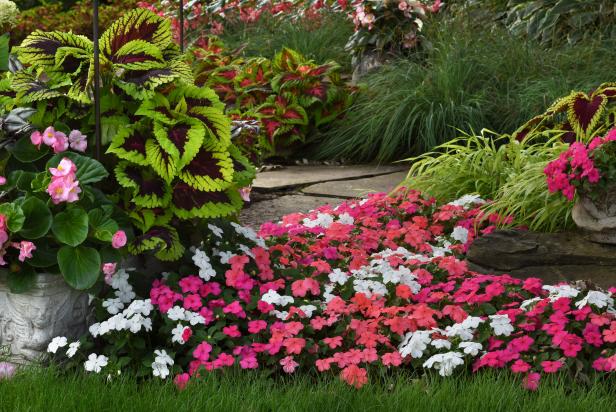
Bright and colorful annuals like Impatiens thrive in shaded areas, making them ideal for illuminating dark corners while attracting hummingbirds.
Impatiens flourish in moist and well-draining soil, thriving in deep shade. Hanging them on your porch can also yield positive results. Typically, these plants are purchased as tray-grown seedlings and planted close together to create dense mats of flowers and leaves.
Seeds can be collected from mature plants and sown indoors 10 weeks before the last frost, as they require a significant amount of time to flower. Cuttings can also be taken in autumn, grown indoors until the frost subsides, and then transplanted.
– Common Name: Impatiens, jewelweed, touch-me-not, snapweed, and patience
– Scientific Name: Impatiens
– Growing Zones: 2 – 11
– Sun: Shade or partial shade
– Soil: Rich, well-draining
– Colors: Red, pink, purple, yellow, coral
– Height: 6 – 36 inches
– Spread: 1 – 3 feet
– Plant Type: Annual
6. Columbine
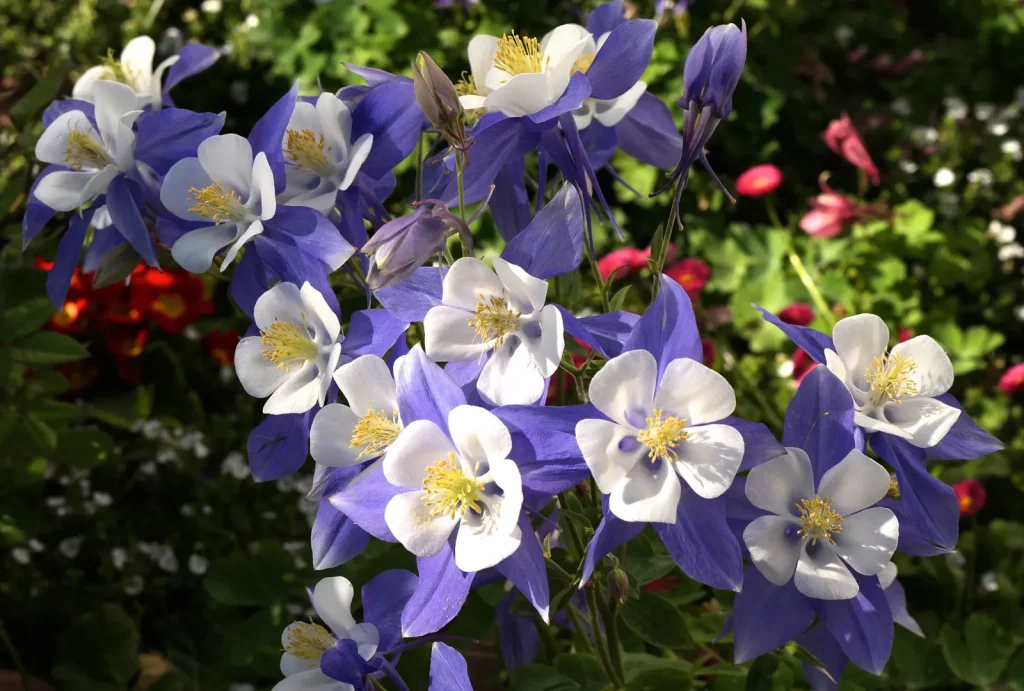
Columbines rank among the best plants for attracting hummingbirds due to their vibrant array of colors and adaptability to partial shade.
Columbine, scientifically known as Aquilegia, is an elegant perennial plant bearing spiky, bell-shaped blooms measuring between 3 and 6 inches in length. Various species and varieties exist, but most thrive in sun to full shade and begin blooming as early as spring.
Notably shade-tolerant, columbines also possess drought tolerance and are resistant to deer. Sow columbine seeds directly in the ground during spring, allowing them to self-seed if desired. For earlier blooms, start seeds indoors 6 to 8 weeks before the last frosts. Keep in mind that flowers may not appear until the second year for seed-grown plants.
– Common Name: Columbine, Aquilegia
– Scientific Name: Aquilegia
– Growing Zones: 3 – 9
– Sun: Full sun to partial shade
– Soil: Neutral pH, moist but not wet soil
– Colors: Red, pink, blue, orange, white, yellow
– Height: 1 – 3 feet
– Spread: 1 foot
– Plant Type: Perennial
7. Coneflower
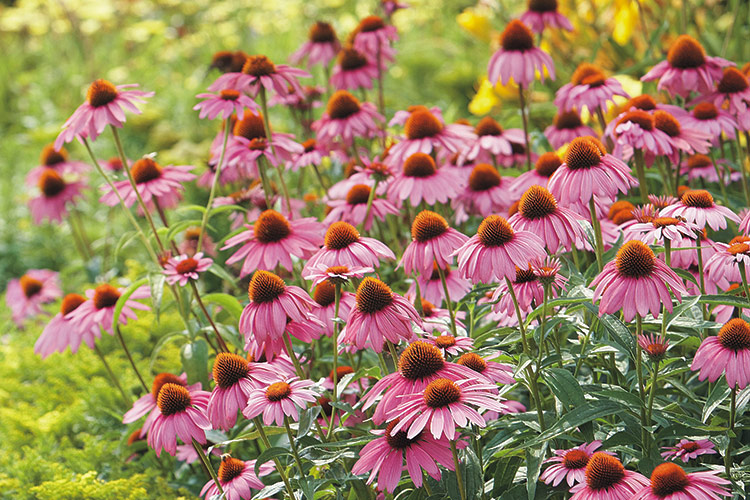
Coneflower, scientifically referred to as Echinacea, represents a genus of flowering plants within the daisy family (Asteraceae). Named for its cone-shaped center, coneflowers come in various species, with the most common being Echinacea purpurea, or the purple coneflower.
Coneflowers feature large, colorful blooms measuring around 6 inches across, standing atop stalks reaching heights of about 5 feet. The color palette includes pink, red, orange, yellow, and white, depending on the specific variety. Thriving in full sun and well-drained soil, these flowers persist from summer to fall. Their vibrant hues, particularly reds and purples, attract hummingbirds, bees, and butterflies with their nectar-rich central cones.
– Common Name: Coneflower
– Scientific Name: Echinacea
– Growing Zones: 3 – 9
– Sun: Full sun
– Soil: Varies
– Colors: White, yellow, orange, pink, red, purple, green
– Height: 2 – 5 feet tall
– Spread: 1 ½ – 2 feet wide
– Plant Type: Perennial
8. Penstemon
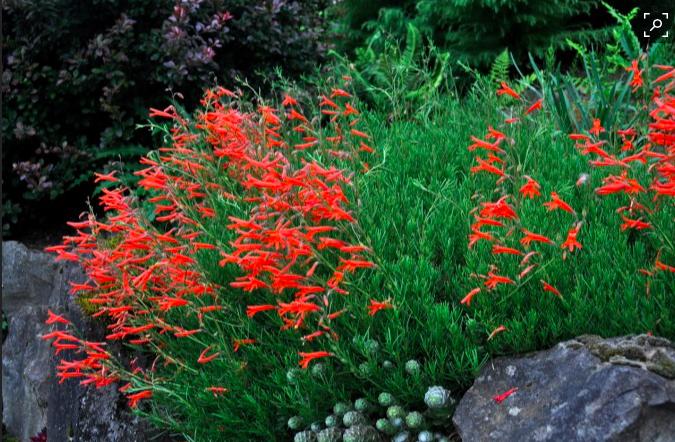
Penstemon encompasses a genus of over 250 ornamental flowering plants belonging to the plantain family (Plantaginaceae). These plants, including snapdragons and foxgloves, are often referred to as Beardtongue due to the tuft of small hairs on the pollen-free stamen protruding from the flowers.
Offering a wide range of species and varieties, Penstemon plants present various sizes and colors. However, they share several characteristics: drought tolerance, attraction for hummingbirds and bees, ease of care, and the ability to brighten any backyard with their lovely blooms.
Penstemon flowers bloom in early summer, featuring spires adorned with clusters of tubular flowers in an array of colors, including blue, purple, red, orange, white, pink, and yellow. Hummingbirds are drawn to their vibrant colors and nectar-rich blooms.
For optimal growth, plant penstemons in areas where they can receive full sunlight. This promotes abundant blooming and prevents stems from drooping due to excessive shade. They prefer nutrient-poor soil with moist conditions, although they can tolerate drought. Selecting a variety suited to your specific soil and climate conditions will enhance their longevity.
– Common Name: Penstemon, foxglove beard-tongue, foxglove beardtongue, talus slope penstemon, and white beardtongue
– Scientific Name: Penstemon
– Growing Zones: 3 – 9
– Sun: Full sun
– Soil: Lean, fast-draining soil
– Colors: Blue, purple, red, orange, white, pink, yellow
– Height: 6 to 12 inches, 1 to 3 feet, 3 to 8 feet
– Spread: 8 to 20 inches
– Plant Type: Perennial
9. Summersweet

Summersweet, scientifically known as Clethra alnifolia, represents a flowering shrub that not only adds beauty to your garden but also attracts hummingbirds.
Native to eastern North America, Summersweet thrives in various climates, particularly wetlands and edges of ponds and streams. Adorned with vertical spikes of fragrant white flowers against dark green foliage, Summersweet brings aesthetic delight. During autumn, its green leaves turn yellow or gold.
Blooming between July and August, Summersweet flowers measure 2 to 6 inches long, displaying colors ranging from white to pink. The fragrant scent emitted by these flowers proves enticing to butterflies, hummingbirds, and other pollinators. Additionally, the pepper-like seeds they produce serve as a magnet for birds during autumn.
Summersweet plants prefer moist to wet soil and shade. They thrive in the shade, resulting in larger blooms compared to those exposed to excessive sunlight. Salty air poses no issue, as Summersweet is naturally adapted to coastal regions. Adequate watering should be provided during dry weather conditions. To maintain optimal growth, allow room for the plant to spread and prune old branches in spring for new growth and desired shaping.
– Common Name: Summersweet, coastal sweet pepperbush
– Scientific Name: Clethra alnifolia
– Growing Zones: 3 – 9
– Sun: Full sun or partial shade
– Soil: Moist to wet soil, slightly acidic
– Colors: White, pink, or rose-colored
– Height: 4 – 8 feet tall
– Spread: 4 – 6 feet wide
– Plant Type: Perennial, Deciduous shrub
10. Yarrow
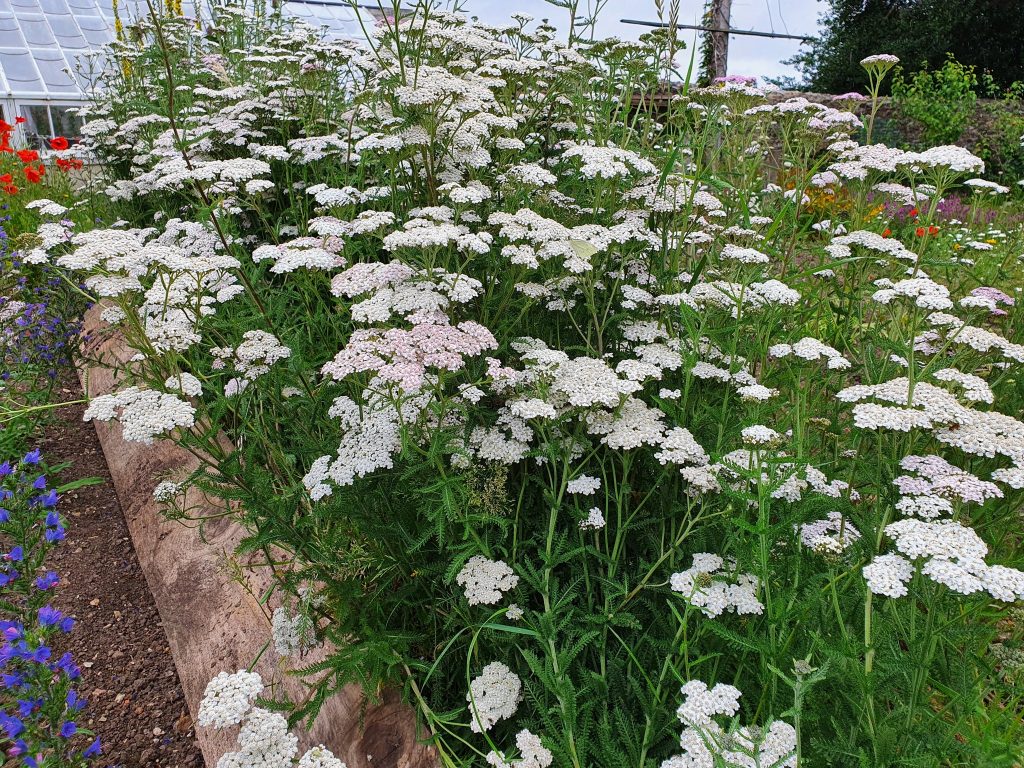
Yarrow, scientifically referred to as Achillea millefolium, possesses a wealth of folklore tied to its name. “Achillea” pays homage to the mythical Greek hero Achilles, who supposedly used yarrow to
treat his soldiers’ wounds. It is also known as “Nosebleed” for its potential to start or stop nosebleeds. “Millefolium” translates to “thousand leaves,” representing the plant’s feather-like appearance due to its finely divided foliage.
Common Yarrow is a sought-after plant for many gardens due to its clusters of tiny, colorful flowers, which can be white, yellow, pink, or red, depending on the variety. These flowers grow tightly together, ranging from 15 to 40 per cluster.
The feathery leaves of Yarrow are evenly distributed along the stems and can measure 2 to 8 inches in length. They exhibit an aromatic fragrance and a soft, fern-like appearance.
Apart from their aesthetic appeal, Yarrow flowers serve as major attractants for pollinators like hummingbirds, bees, and butterflies. Cultivating Yarrow is a straightforward process, requiring full sunlight exposure and adequate watering to keep the plants hydrated.
Additionally, Yarrow has been traditionally used to address various ailments such as wounds, burns, colds, fever, and headaches.
– Common Name: Common Yarrow, Milfoil, Nosebleed, Thousand-leaf
– Scientific Name: Achillea millefolium
– Growing Zones: 3 – 9
– Sun: Full sun
– Soil: Sandy, loamy, clay, well-draining
– Colors: White, yellow, pink, red
– Height: 2 to 3 feet tall
– Spread: 2 to 3 feet wide
– Plant Type: Perennial
11. Butterfly Weed
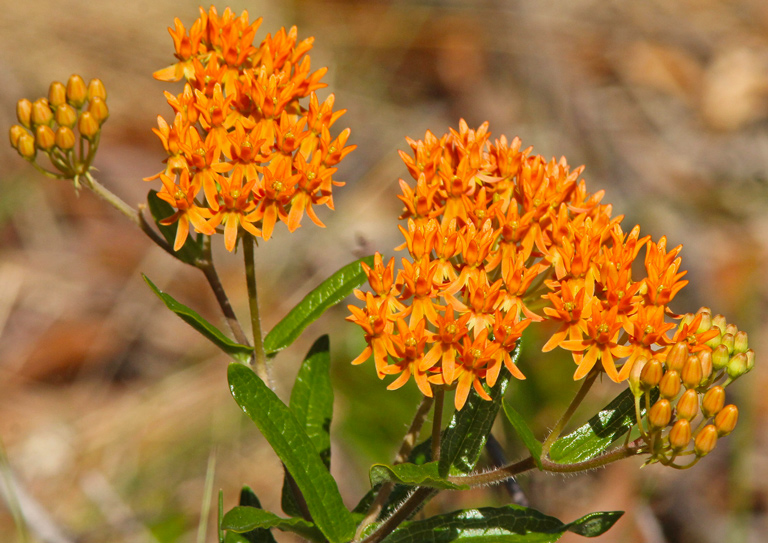
Butterfly Weed, scientifically known as Asclepias tuberosa, is a bushy and eye-catching plant with historical medicinal uses. It is also called Pleurisy Root due to its association with the treatment of pleurisy and other pulmonary ailments. Despite belonging to the Milkweed family, it lacks the milky sap typically found in milkweeds. However, it remains a vital plant for attracting butterflies, bees, and hummingbirds.
Butterfly Weed showcases clusters of orange to yellow, nectar-rich flowers atop thick and hairy stems, complemented by lush green foliage. These blooms can be enjoyed from late spring to summer. If self-seeding is undesired, it is crucial to remove the seed pods, as Butterfly Weed can exhibit invasive tendencies.
Cultivating Butterfly Weed is relatively easy, but it requires patience, as it may take up to three years to witness its flowers. It is advisable to plant them in a permanent location, as they possess tuberous roots and dislike being moved. These plants thrive under full sunlight and exhibit minimal water requirements once established.
In addition to their visual appeal and ability to attract pollinators, Butterfly Weed plays a crucial role in the preservation of monarch butterflies. These butterflies rely on milkweed leaves as a food source for their caterpillars.
– Common Name: Butterfly Flower, Butterfly Weed, Orange Milkweed, Pleurisy Root
– Scientific Name: Asclepias tuberosa
– Growing Zones: 3 – 9
– Sun: Full sun
– Soil: Poor, dry, well-draining soil
– Colors: Orange, yellow, or red
– Height: 1 to 2 feet tall
– Spread: 12 to 18 inches wide
– Plant Type: Perennial
12. Honeysuckle Vine
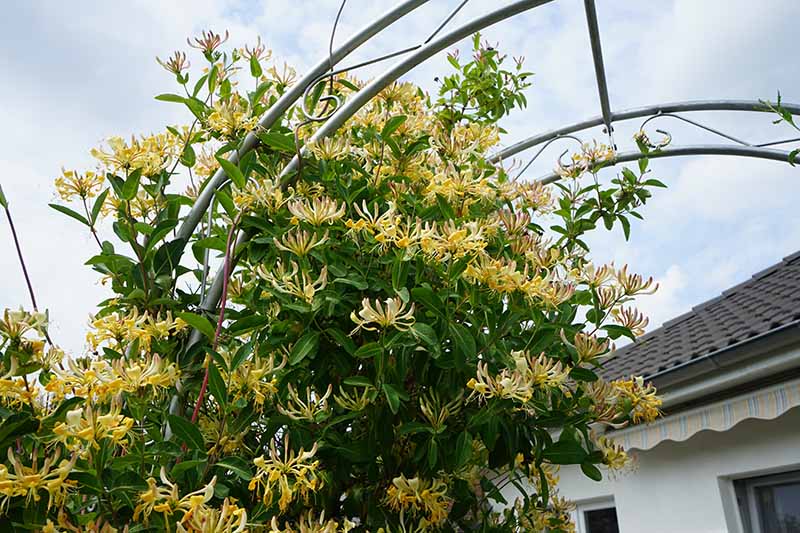
The Honeysuckle vine, belonging to the Caprifoliaceae family, is a delightful addition to any garden. With its fragrant flowers and attractive foliage, it is sure to catch the attention of hummingbirds.
Honeysuckle vines are vigorous climbers that twine around trellises, fences, or arbors, creating a beautiful vertical display. Their tubular flowers come in various colors, including yellow, orange, red, and pink, and emit a sweet fragrance that lures hummingbirds.
These vines prefer full sun but can tolerate some shade. They require well-drained soil and regular watering to thrive. Pruning can be done after flowering to maintain their shape and encourage new growth.
The Honeysuckle vine is a wonderful choice for gardeners looking to attract hummingbirds while adding a touch of beauty and elegance to their outdoor spaces.
Common Name: Honeysuckle vine
Scientific Name: Caprifoliaceae family
Growing Zones: Varies depending on the species
Sun: Full sun to partial shade
Soil: Well-drained
Colors: Yellow, orange, red, pink
Height: Varies depending on the species
Spread: Varies depending on the species
Plant Type: Perennial, Climbing vine
13. Fuchsia

Fuchsia plants are a captivating addition to any garden with their elegant, dangling flowers that resemble delicate ballerinas. These flowering shrubs are native to Central and South America and belong to the Onagraceae family.
Fuchsia flowers come in a wide range of colors, including shades of pink, purple, red, and white. Their unique shape, with elongated petals and contrasting sepals, creates a stunning display that is irresistible to hummingbirds.
These plants thrive in partial shade, making them perfect for shady areas in your garden. They prefer moist, well-drained soil and benefit from regular watering to keep the soil consistently moist. Pruning can be done to maintain a compact shape and encourage new growth.
With their vibrant and enchanting flowers, fuchsias are sure to attract hummingbirds and add a touch of charm to your outdoor space.
Common Name: Fuchsia
Scientific Name: Onagraceae family
Growing Zones: Varies depending on the species
Sun: Partial shade
Soil: Moist, well-drained
Colors: Pink, purple, red, white
Height: Varies depending on the species
Spread: Varies depending on the species
Plant Type: Perennial, Flowering shrub
14. Butterfly Bush

Butterfly bushes, scientifically known as Buddleja, are a delightful addition to any garden with their abundant and vibrant flowers. These deciduous shrubs belong to the Scrophulariaceae family and are widely known for their ability to attract butterflies and hummingbirds.
The butterfly bush’s elongated flower spikes are filled with tiny, nectar-rich flowers that come in a variety of colors, including purple, pink, white, and yellow. These flowers release a sweet fragrance that entices hummingbirds and other pollinators.
These shrubs thrive in full sun and well-drained soil. They are relatively low-maintenance and can tolerate drought conditions once established. Pruning in early spring helps promote new growth and a more compact shape.
By planting a butterfly bush in your garden, you not only provide a beautiful focal point but also create a haven for hummingbirds and butterflies to enjoy.
Common Name: Butterfly Bush
Scientific Name: Buddleja
Growing Zones: Varies depending on the species
Sun: Full sun
Soil: Well-drained
Colors: Purple, pink, white, yellow
Height: Varies depending on the species
Spread: Varies depending on the species
Plant Type: Deciduous shrub
15. Columbine

Columbines, scientifically known as Aquilegia, are charming perennial flowers that belong to the Ranunculaceae family. These delicate flowers with distinctive spurred petals are a favorite of hummingbirds and add a touch of grace to any garden.
Columbine flowers come in various colors, including shades of blue, purple, pink, red, yellow, and white. Their unique shape, resembling a bonnet or an inverted bell, makes them highly attractive to hummingbirds seeking nectar.
These perennials thrive in partial shade and prefer well-drained soil. Regular watering is necessary to keep the soil evenly moist, especially during dry periods. Deadheading spent flowers can encourage continuous blooming.
With their alluring flowers and ability to attract hummingbirds, columbines are a must-have for any garden enthusiast.
Common Name: Columbine
Scientific Name: Aquilegia
Growing Zones: Varies depending on the species
Sun: Partial shade
Soil: Well-drained
Colors: Blue, purple, pink, red, yellow, white
Height: Varies depending on the species
Spread: Varies depending on the species
Plant Type: Perennial, Herbaceous flower
16. Penstemon
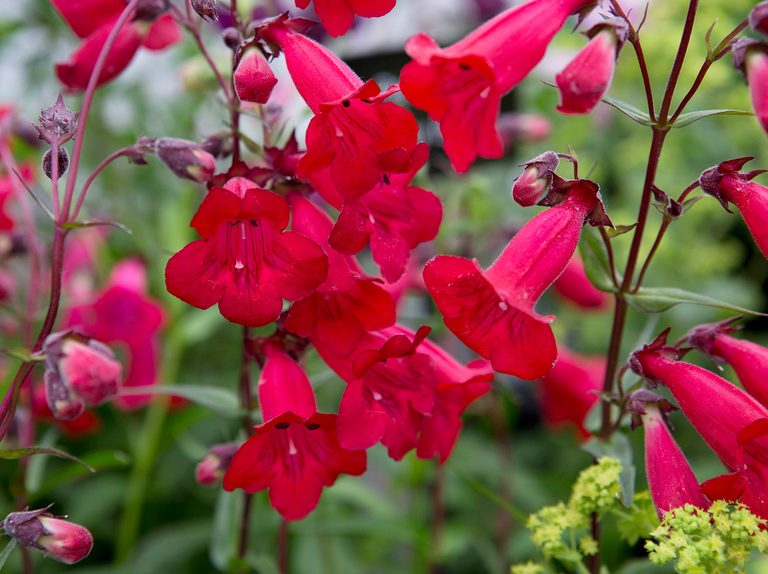
Penstemons are a diverse group of flowering plants belonging to the Scrophulariaceae family. With over 250 species, these perennials are renowned for their tubular flowers that attract hummingbirds with their abundant nectar.
The flowers of penstemons come in a wide array of colors, including shades of red, pink, purple, blue, and white. Their tubular shape and long stamens make them a perfect fit for hummingbirds’ slender bills.
These plants prefer full sun to partial shade and well-drained soil. They are relatively drought-tolerant once established but appreciate regular watering during dry spells. Deadheading spent flowers can prolong the blooming period and encourage new growth.
With their captivating flowers and hummingbird appeal, penstemons bring beauty and vibrancy to any garden landscape.
Common Name: Penstemon
Scientific Name: Scrophulariaceae family
Growing Zones: Varies depending on the species
Sun: Full sun to partial shade
Soil: Well-drained
Colors: Red, pink, purple, blue, white
Height: Varies depending on the species
Spread: Varies depending on the species
Plant Type: Perennial, Flowering plant
17. Agastache

Agastache, also known as hyssop or hummingbird mint, is a genus of flowering plants in the Lamiaceae family. These perennials are cherished for their aromatic foliage and attractive flower spikes that are highly attractive to hummingbirds.
The flowers of agastache come in various shades of purple, pink, orange, and white. They grow densely on upright spikes, providing a bountiful supply of nectar for hummingbirds to enjoy.
These plants thrive in full sun and well-drained soil. They are generally drought-tolerant and require minimal watering once established. Regular pruning after blooming helps maintain a neat appearance and encourages further growth.
By planting agastache in your garden, you can create a fragrant and visually appealing haven that will surely entice hummingbirds.
Common Name: Agastache, hyssop, hummingbird mint
Scientific Name: Lamiaceae family
Growing Zones: Varies depending on the species
Sun: Full sun
Soil: Well-drained
Colors: Purple, pink, orange, white
Height: Varies depending on the species
Spread: Varies depending on the species
Plant Type: Perennial, Flowering plant
18. Cardinal Climber
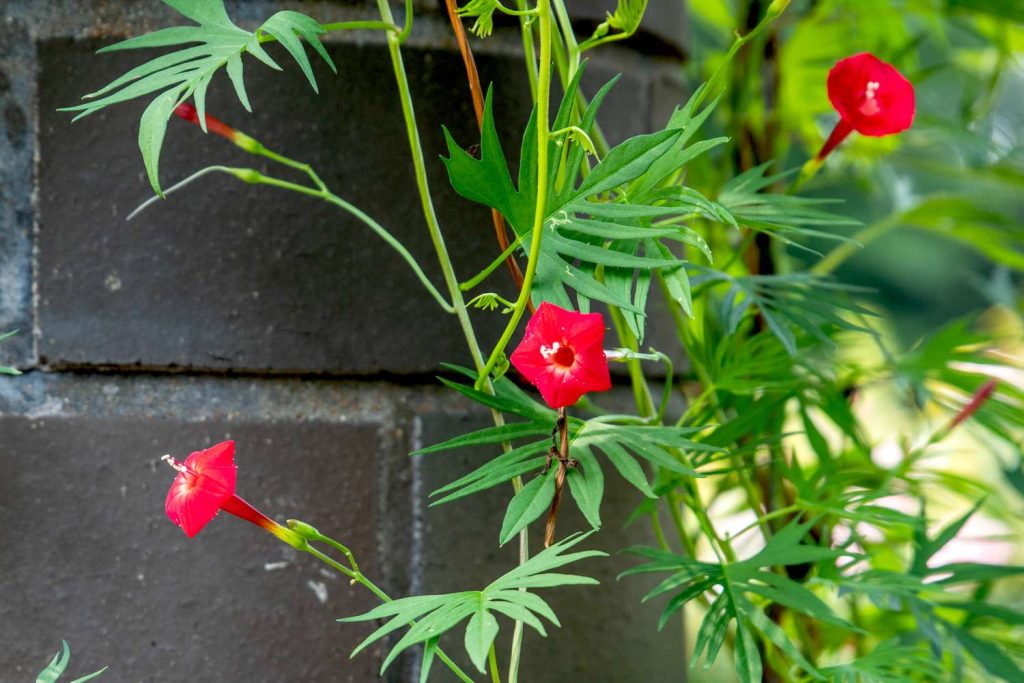
Cardinal climber, scientifically known as Ipomoea sloteri, is a charming annual vine that belongs to the Convolvulaceae family. With its vibrant red flowers and attractive foliage, it is a magnet for hummingbirds.
The trumpet-shaped flowers of the cardinal climber are a striking shade of red, resembling the vibrant plumage of a cardinal bird. These flowers provide a generous amount of nectar, making them highly appealing to hummingbirds.
This vine thrives in full sun and well-drained soil. It requires a trellis or support to climb and can add vertical interest to your garden. Regular watering and fertilizing can help promote healthy growth and abundant blooms.
With its fiery red flowers and hummingbird allure, the cardinal climber is a fantastic choice for adding a touch of vibrant beauty to your outdoor space.
Common Name: Cardinal Climber
Scientific Name: Ipomoea sloteri
Growing Zones: Annual (grown as an annual)
Sun: Full sun
Soil: Well-drained
Colors: Red
Height: Varies depending on the support
Spread: Varies depending on the support
Plant Type: Annual vine
19. Lobelia
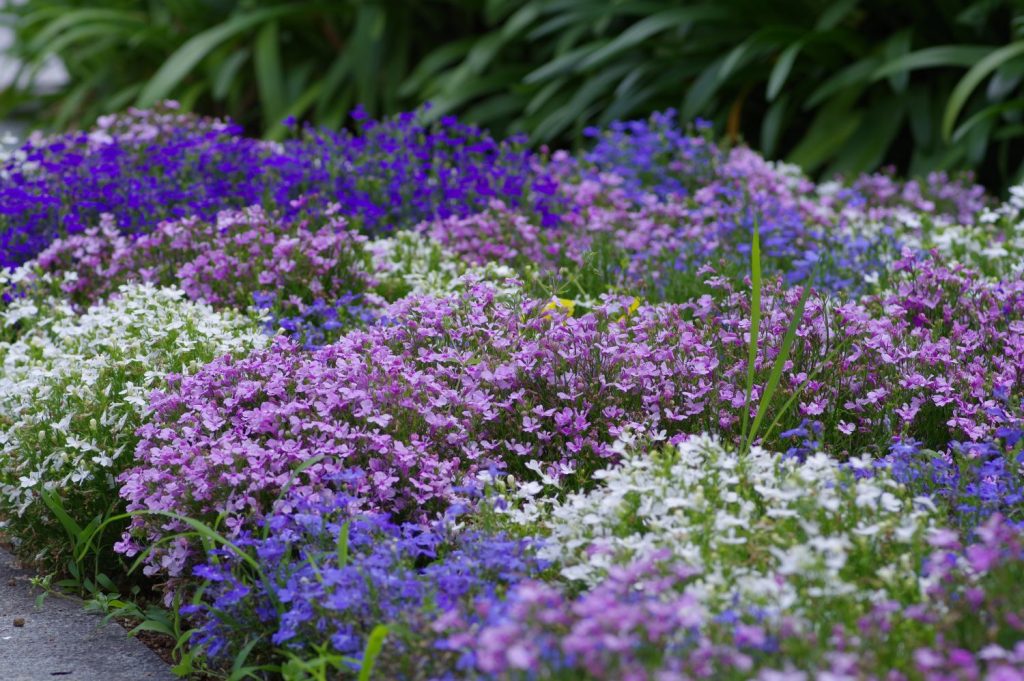
Lobelia is a genus of flowering plants in the Campanulaceae family, known for its showy blooms and ability to attract hummingbirds. With over 400 species, lobelias offer a wide range of options for gardeners seeking to entice these delightful birds.
The flowers of lobelias come in various shades of blue, purple, red, and white. Their tubular shape and abundant nectar make them a favorite among hummingbirds seeking a sweet treat.
These plants thrive in full sun to partial shade and moist, well-drained soil. They appreciate regular watering to keep the soil consistently moist. Deadheading spent flowers can promote continuous blooming and enhance the plant’s appearance.
By incorporating lobelias into your garden, you can create a colorful and hummingbird-friendly oasis that will bring joy and beauty to your outdoor space.
Common Name: Lobelia
Scientific Name: Campanulaceae family
Growing Zones: Varies depending on the species
Sun: Full sun to partial shade
Soil: Moist, well-drained
Colors: Blue, purple, red, white
Height: Varies depending on the species
Spread: Varies depending on the species
Plant Type: Perennial or annual, depending on the species
